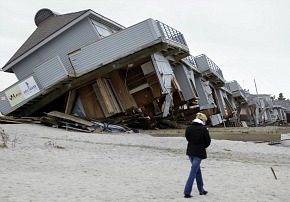Catastrophe modeling firm AIR Worldwide today revised up its industrywide Sandy insured loss estimates to the $16 billion-$22 billion range.
AIR Worldwide had previously estimated on Oct. 30 — the day after Sandy made U.S. landfall — that insured losses from Sandy would be between $7 billion and $15 billion.
AIR Worldwide said it has been analyzing Sandy’s characteristics and impacts since it made landfall on Oct. 29. The firm said it revised its estimate after incorporating the latest available information on surge height and extent, surface wind speed observation data, and findings from AIR’s post-disaster survey teams.

AIR estimates include wind and storm surge damage to onshore residential, commercial and industrial properties and their contents, automobiles, and time element coverage (additional living expenses for residential properties and business interruption for commercial properties).
“The significant increase in estimated losses from AIR’s estimate issued on October 30, the day after Sandy’s landfall, is driven primarily by an increase in estimated losses from storm surge damage,” said Dr. Tim Doggett, principal scientist at AIR Worldwide.
“This, in turn, is driven by a reassessment of the percentage of flood losses that will actually be paid, as well as an improved storm surge footprint run against high-resolution industry exposure information.”
AIR offered commentary on notable factors that influenced the firm’s update of insured loss estimates. On commercial flood insurance penetration, AIR said its default assumption — and the one used to generate insured loss estimates hours after Sandy’s landfall — was that 10 percent of commercial structures carry flood insurance.
However, based on further investigation into how storm surge losses will be covered under Sandy, AIR said it now believes that a revised assumption of 20 percent is more applicable for this particular storm and region. Therefore, the above range of losses reflects the assumption that 20 percent of the damage from Sandy’s storm surge to commercial and industrial properties will be covered.
On homeowners deductibles, AIR said that one hour before Sandy made landfall, the National Hurricane Center (NHC) issued a public advisory, which stated that the storm had transitioned from a hurricane to a post-tropical cyclone.
In the days following landfall, officials in New York, New Jersey, Connecticut, Delaware, Maryland, New York, Pennsylvania, Rhode Island and Washington, D.C., all ruled that insurers may not impose hurricane deductibles on homeowners policies in their jurisdictions. (In AIR’s initial loss estimates for Sandy posted on October 30, hurricane deductibles were applied.)
Comparing AIR’s revised estimate to other major CAT modeling firms, Eqecat’s insured loss estimate for Sandy is now between $10 billion to $20 billion. (up from a previous estimate of $5 billion to $10 billion). Risk Management Solutions has not yet published its estimate publicly. But according to a report from The Wall Street Journal, RMS has told its corporate clients that insured loss estimate for Sandy would be in the range of $20 billion to $25 billion.
The following is the list of relevant factors that impacted AIR’s new estimates, according to the firm’s announcement.
AIR’s updated loss estimates reflect:
• Insured physical damage to property (residential, commercial, industrial, auto), both structures and their contents;
• Additional living expenses (ALE) for residential claims;
• For residential lines, estimates reflect a flat $750 deductible as opposed to hurricane deductible assumptions normally used in AIR industry loss estimates;
• For residential lines, estimates reflect AIR’s view that insurers will ultimately pay 10 percent of modeled storm surge damage as wind losses;
• For commercial lines, insured physical damage to structures and contents, and business interruption directly caused by storm surge, assuming that 20 percent of commercial storm surge will be covered (Note: Other flood losses are not modeled or reflected in estimates); business interruption losses include direct and indirect losses for insured risks that experience physical loss;
• For the automobile line, estimates reflect AIR’s view that insurers will pay 100 percent of storm surge damage;
• Demand surge.
Loss estimates do not reflect:
• Losses paid out by the National Flood Insurance Program
• Losses resulting from the compromise of flood defenses (e.g., natural and man-made levees);
• Losses from the flooding of tunnels, subways, and other infrastructure;
• Losses to uninsured properties;
• Low-level losses in states distant to the storm’s center that have resulted from the interaction between Sandy and another frontal system to the west;
• Losses from extra-contractual obligations;
• Losses from hazardous waste cleanup, vandalism or civil commotion whether directly or indirectly caused by the event;
• Other non-modeled losses;
• Losses for U.S. offshore assets and non-U.S. property (AIR estimates these losses separately).
Topics USA Profit Loss Flood Hurricane Funding
Was this article valuable?
Here are more articles you may enjoy.


 Dubai Floods Expose Weaknesses to a Rapidly Changing Climate
Dubai Floods Expose Weaknesses to a Rapidly Changing Climate  JPMorgan Client Who Lost $50 Million Fortune Faces Court Setback
JPMorgan Client Who Lost $50 Million Fortune Faces Court Setback  Marsh McLennan Agency to Buy Fisher Brown Bottrell for About $316M
Marsh McLennan Agency to Buy Fisher Brown Bottrell for About $316M  South Carolina Ringleader Sentenced to 8 Years for Staged Accidents
South Carolina Ringleader Sentenced to 8 Years for Staged Accidents 

